What you should know about brainstorming
Creating ideas is vital in growing your business and staying relevant in a constantly changing environment. Since the change is affecting across industries, everyone needs to innovate. Brainstorming is an ideation method where group members spontaneously throw ideas to find a solution for a specific problem. Brainstorming is ideal when you want to create many ideas in a short period of time.
Brainstorming is extremely helpful since it forces you to think outside the box and come up with new ideas. What makes brainstorming convenient is that you can use it for really any subject.
Even though brainstorming is widely used, many of us need some tips on how to make brainstorming activities even better. In this post, we’ll provide an all-encompassing rundown of brainstorming. We'll talk about the importance of group brainstorming, how to succeed in it, and what are the different techniques of brainstorming.
.jpg?width=932&height=641&name=brainstorming%20(9).jpg)
Table of contents:
What is Brainstorming and Why Does it Matter?
How to brainstorm? - Step-by-step guide
Tips and Reminders for a brainstorming session
Alternative Brainstorming Techniques
Example of Brainstorming Online
What is Brainstorming and Why Does it Matter?
Brainstorming is an ideation method that is widely used in the design thinking process. Brainstorming can be defined as a group problem-solving technique where the members contribute ideas spontaneously. In practice, brainstorming is often synonymous with a creative and imaginative idea-generating process.
Brainstorming is a very common method among businesses. Many people associate brainstorming with things like generating new products or business ideas. However, brainstorming can be used for basically anything. Improving services, processes, customer research, you name it.
Brainstorming is an optimal method when you want a wide range of creative and original ideas. It's also great for involving everyone in a group.
Brainstorming is often used for problem-solving in business since it is a very effective method. The advantage of brainstorming is that it combines problem-solving and creative thinking. It is a quick way to generate and share new ideas.

Commonly, some ideas born in brainstorming might seem crazy, but that’s one benefit of it. Sometimes the wildest idea might turn out to be the greatest. People are often too shy to share crazy ideas and are too caught up in their routines to think outside the box. Brainstorming allows free thinking and openness to new or even wild ideas. To create great ideas, you must have some bad ideas too. Free ideation rarely happens by itself, you have to make time and place for it.
The advantage of group brainstorming is also that it can help your team building. Brainstorming is a team sport and the results stem from strong collaboration. Brainstorming allows a comfortable safe space for team members to bounce up some ideas without the fear of being judged.
The History of Brainstorming
Brainstorming was introduced in 1953 by businessman and creativity theorist Alex Osborn. Already in 1938, he had invented the term “thinking up” which meant a creative idea generation process. It was initially created as a solution for the lack of shared creativity which caused subpar results in business meetings in his company BBDO.
Brainstorming was popularized in 1953 in Osborn’s book “Applied Imagination”. It became popular quickly and in five years, eight out of ten of the largest companies in America were using brainstorming.
Brainstorming has evolved a lot since. The subject has been researched a lot, and improvements have been done to address its shortcomings. New brainstorming techniques have been invented and the original technique has improved. It is still a widely used method in problem-solving and ideation.
Brainstorming is probably the first method that comes to your mind when thinking about generating ideas. The term is used quite loosely today, but the original goals and rules are very specific. Even though brainstorming was introduced decades ago, the core of it remains the same.
The Pros and Cons of Brainstorming
Brainstorming is a useful tool with many benefits:
- Teamwork: Group brainstorming involves the whole team sharing their ideas and working together to find the best solutions. The ideas are developed together, and no one person gets the credits.
- Free thinking: judgment is not allowed in brainstorming, so the participants can think outside the box.
- Idea building: Since brainstorming is teamwork, others can join in improving your ideas. It is also common that one idea inspires the other.
- Out-of-the-box innovating: When the members are thinking without restrictions, there are no limits for innovation. Brainstorming triggers innovative solutions that wouldn’t come to mind otherwise.
- Ongoing collaboration: Group brainstorming improves collaboration. It encourages members to share ideas also outside the brainstorming sessions
Although there are many benefits of group brainstorming, there are also reasons why it isn’t always the best solution. Here are some pitfalls of brainstorming:
- Utopic ideas:
- Even though wild ideas are also a pro of brainstorming, they can also be a con, if the ideas are unworkable
- Ineffective:
- Participants have varying communication skills. For some, it is hard to express their ideas and for others, it is difficult to listen. That can lead to ineffective sessions.
- Favors verbally talented:
- Some participants could be amazing at creating new ideas one-on-one but might be overrun in group brainstorming by more loud ones.
- Time-consuming:
- Brainstorming is a process. It is not a quick fix for the problem. It takes time and one might need multiple sessions to reach results.
- Anchoring
- There is a risk to fall for a cognitive bias called anchoring. It means that people tend to focus too much on the first pieces of information and don’t explore the latter options properly. In this case first or dominant idea gets all the attention and other ideas will not receive equal opportunity.
Brainstorming has its disadvantages but you can try to tackle those by following the brainstorming rules. You can also try other brainstorming techniques that address the shortcomings of brainstorming. Also, it is noticeable that some of the disadvantages people associate with brainstorming are a result of a misunderstanding. Brainstorming term is used quite loosely, and the core idea is sometimes forgotten.
How to brainstorm? - Step-by-step guide
1. Define the problem or topic you want to brainstorm
Before you start brainstorming, it is important to define the problem or topic you want to brainstorm. This will help you stay focused and generate relevant ideas.
2. Gather your participants
Brainstorming works best when the participants brainstorm together. You can brainstorm in groups of two or more but try not to include too many brainstormers to avoid groupthink. Also, make sure that there is one person leading and facilitating the brainstorming session.
3. Assign a recorder
The recorder is responsible for noting down all the ideas that are brainstormed during the session. People with great organizational skills are always the best choice. Having someone as a recorder helps in staying focused and on time.
4. Set a time limit
This is especially important when brainstorming with a large group. Otherwise, people will tend to go off-topic and the brainstorming session will take too much time.
5. Set ground rules
Brainstorming rules are meant to make brainstorming sessions efficient. Hence, brainstorming rules are not meant to restrict brainstorming. They should inspire brainstormers to think freely while giving the chance for everyone to share their ideas.
6. Start brainstorming
Now it's time to brainstorm! This involves coming up with as many ideas as possible, no matter how crazy or unrealistic they may seem.
Start brainstorming with a warm-up activity that allows participants to get in touch and interact more easily. A good way to start brainstorming is by asking open-ended questions to generate ideas. For example, the first question could be: "What are different ways we could improve our customer service?" This will get the brainstorming process started and people will begin to offer ideas.
Make sure the recorder writes down every idea that is brainstormed, no matter how far-fetched they may seem.
7. Group and build on brainstorming ideas.
Once you have brainstormed a list of ideas, it is important to group them and build on them. This will help you to develop a better understanding of the topic and find patterns in the ideas. Allowing other participants to brainstorm on top of previous ideas will help to develop the ideas further and could lead to some very innovative solutions.
8. Evaluate brainstorming ideas
Evaluating brainstorming ideas is a critical step in the brainstorming process. This is where you determine whether the ideas are feasible
- ideas are worth exploring further
- ideas meet the objectives of the brainstorming session
9. Vote for the best brainstorming ideas
Once all the ideas have been brainstormed, it's time to vote on the best ones. Ask everyone to vote for ideas they think are the most effective and viable. The best ideas will then be turned into a plan of action.
10. End brainstorming
Make sure to end brainstorming sessions on time. This will allow participants to reflect on what they’ve brainstormed and prepare for the next session. Brainstorming can be a tiring process so it’s important to also have breaks in between.
11. Document and review brainstorming results
Documenting brainstorming results is a great way to ensure that everyone understands the ideas that were generated, and it can also help to track progress on specific projects.
Reviewing brainstorming results helps to ensure that the best ideas are selected and that an action plan is made on the results of brainstorming.
Brainstorming Rules
We have learned the benefits of brainstorming by now, but to utilize the full potential of this tool, you must know the rules. Often brainstorming sessions do not reach their objectives, because brainstorming rules and best practices are not followed.
Osborn defined 4 principles of brainstorming. Their goal is to release free idea creation and add creativity.
The 4 rules of brainstorming are:
1. Quantity produces quality.
Focus first on creating lots of ideas. The more diverse ideas there are, the better the chances are for some game-changing ones. There are also more ideas you can choose from when you’re starting to work with them. The quality will come when the ideas are further developed.
Commonly, the first ideas are the most obvious ones. When you go for quantity, you get beyond those common ideas and broaden your horizons.
2. Separate ideation and evaluation.
Avoid criticism and blocking ideas. In ideation, the focus must be on creating an open atmosphere for bouncing ideas without the fear of being judged. Critique is part of the process, but it should be separated from brainstorming.
Surprisingly, a recent article suggests that in a cooperative atmosphere criticism might boost creativity. However, we suggest you avoid criticism generally.
3. Encourage wild ideas.
Unusual ideas are welcomed in brainstorming. Wild ideas help the participants to start thinking outside the box
Obvious ideas don’t often spark the best results, start thinking bigger!
4. Build on created ideas.
Ideas often trigger other ideas. It is advisable to use others’ ideas in generating new ones. Improve and combine the ideas of others and develop them further.
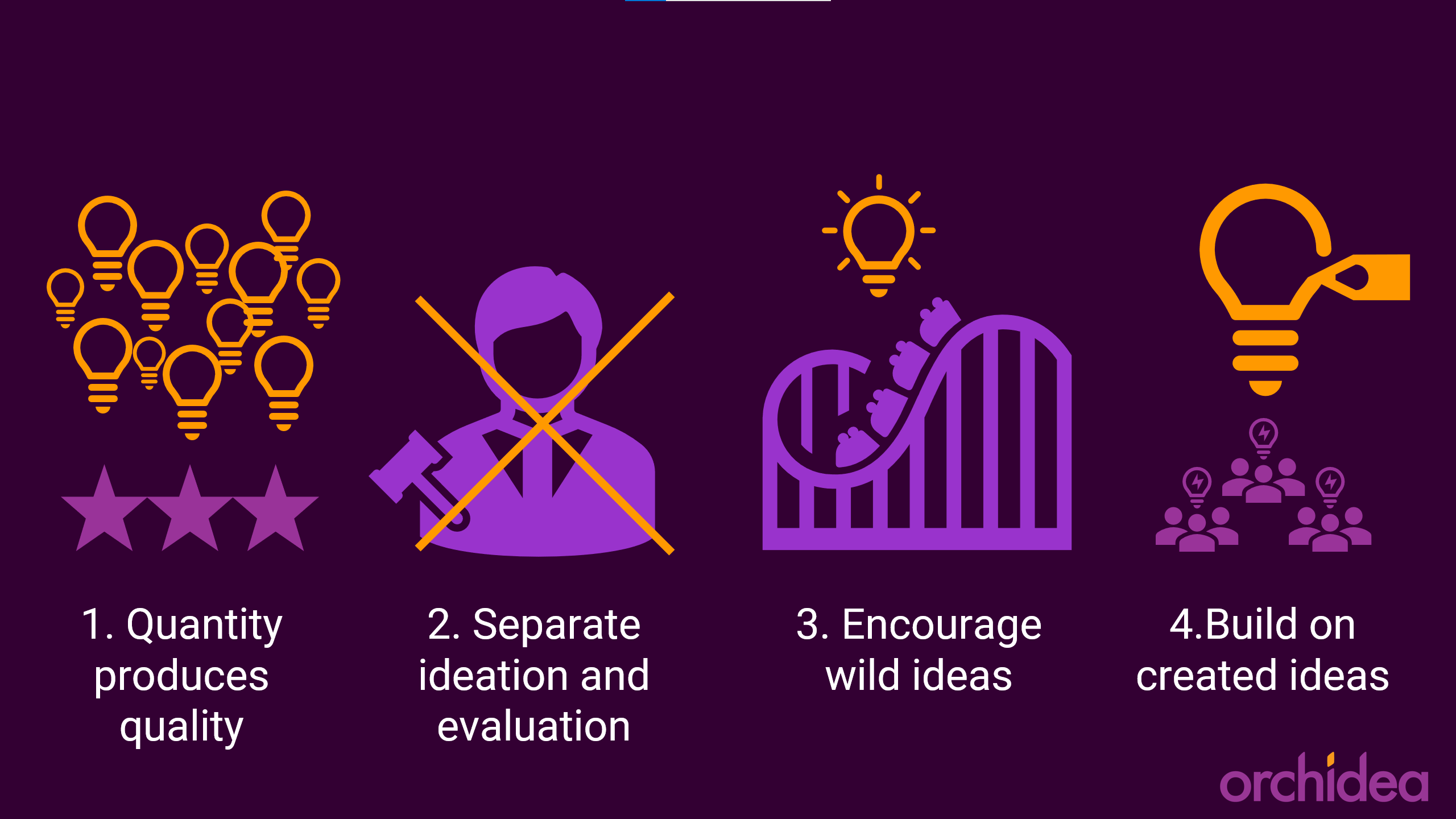
These 4 basic rules are the core of brainstorming. When the brainstorming method has evolved, new rules have been found to be important.
Read the post: Rules for brainstorming success
To make your brainstorming sessions effective, also follow these brainstorming rules:
- One conversation at a time: Even though it is usual that the participants get excited and start throwing more ideas, try to focus on listening. You might miss some great ideas if you’re not hearing them.
- Stay on track: Even though blue-sky ideas and free-thinking are welcomed in brainstorming, it still is important to stay on track. You shouldn't lose focus on the problem you’re trying to solve.
- Reserve time: Brainstorming is time-consuming. You might need to have multiple brainstorming sessions and it is not good for the creativity to rush too much.
- Don’t discard ideas: Preserve every idea so you won’t forget any great ones. Also, some ideas that didn’t seem good or possible to implement, might be that later.
- Make sure everyone shares at least some ideas: It is important to involve everyone and make sure that not only the extroverted ones get heard.
- Make it fun: Don’t get too serious, have some icebreakers, and don’t have too strict timelines.
Even though brainstorming isn’t very hard, it still is good to be aware of the rules that make brainstorming efficient. There are many brainstorming rules you should note down. The main thing to remember is that brainstorming is a process. Plan it well, have a good structure, pay attention to participation, record all the ideas, and create a comfortable atmosphere.
Tips for a successful brainstorming session
Running an actual brainstorming session isn’t difficult, but there are some things you should take into consideration.
Well begun is half done also applies to brainstorming. Having an effective brainstorming session is much easier when you have planned it well.
When you’re preparing for a brainstorming session, define your problem carefully. Also, decide who should be attending the session and how and where are you going to run it. Usually, about 2-10 people are in the group. You also need to determine the facilitator of the session.
During the session, ensure the atmosphere is comfortable for sharing ideas. It is also important to make sure everyone is participating. You can set an example and throw some wild ideas yourself to set the tone for the brainstorming session.
Tips for preparing for a brainstorming session:
- Choose only one problem to brainstorm at the time
- Choose the participants carefully: have a good mix of different backgrounds. Don’t invite too many people.
- Choose the location and prepare it for your brainstorming session
- Seat participants in a circle, and have some post-it notes, whiteboard, pens, etc.
- If you’re brainstorming online, choose a good brainstorming software to make your session effective
- Harness AI in brainstorming to boost the creativity

Tips for running a brainstorming session
- Remind the participants about the rules and agenda and make sure everyone follows them.
- Set a time limit. A good brainstorming session is usually something between 15 to 45 minutes.
- For a warmup, share an embarrassing story. A study showed that creativity increased significantly when team members shared embarrassing stories.
- Encourage the quiet ones. Make sure everyone shares ideas and no one is dominating the discussion.
- Set an example for desired behavior yourself.
Extra tip💡: Brains have a large section for visual thinking, let people draw during the brainstorming session!
Learn more about running successful brainstorming sessions: How to Prepare For and Conduct a Brainstorming Session
Alternative Brainstorming Techniques
Sometimes it is a good idea to change things up and do things differently. Using different brainstorming techniques can enhance your creativity and boost innovation.
There are plenty of alternative brainstorming methods available and each of them has its advantages. Some alternative brainstorming techniques you should consider are:
Reverse brainstorming
When traditional brainstorming is about solving problems, reverse brainstorming is about preventing them. In Reverse brainstorming, the process goes backward. The participants try to figure out how they could cause problems or make current problems worse. Finally, they’ll get to think about how they could do the opposite.
Brainwriting
In brainwriting, everyone writes down anonymously their ideas on paper. After some time, they change papers and develop the ideas further. In the end, the leader facilitates the discussion of the ideas developed.
Read more about this method in our post How to generate ideas with brainwriting?.
Rapid ideation
Rapid ideation is a fast version of brainstorming. The leader briefs the group and sets a timer. The participants write down as many ideas as possible. There are no limits to the ideas, they can be as far-fetched as they are. Probably most of the ideas are going to be discarded, but it is okay since the focus of this brainstorming technique is on idea creation.
These are just some of the possible brainstorming techniques you can benefit from, but there are many more available for you to choose from. To find the best alternative brainstorming techniques for you, learn more about them in our post 16 Best Brainstorming Techniques for Boosting Innovation.
Digital brainstorming
In the digital era, more processes are turning online, and remote work is coming more popular. Being in different locations doesn’t mean that brainstorming should be off the table. That’s why you should consider digital brainstorming, also known as brain netting.
The most important part of online brainstorming is selecting the right virtual brainstorming tools. Luckily, there are many options online. They can be used for both having the entire brainstorming session online or just using online brainstorming tools as a part of your face-to-face brainstorming.
Orchidea Workshop is a great online brainstorming tool. You can use it in a remote brainstorming session with a remote meeting program. Or as a helpful tool in in-person brainstorming sessions.
Brainstorming online is more effective than traditional brainstorming. In digital brainstorming, writing down ideas is easy and fast, and the ideas are immediately stored in the brainstorming software. With Orchidea, you can harness the power of AI to boost your ideation.
The pros of brainstorming with Orchidea Workshop:
- AI-Powered idea generation
- 3-5 times more initial ideas are created than with traditional post-it notes
- The result is more diverse thought and higher-quality ideas
- One facilitator can simultaneously lead several groups with the same or different topic
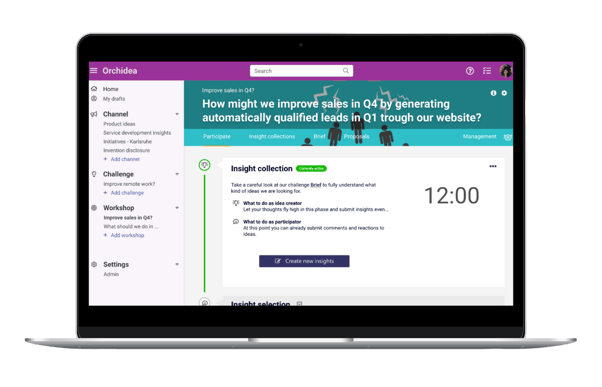
💡In digital brainstorming, using AI in brainstorming can be a great additional source of creativity.
Example of Brainstorming Online
The set up: Remote team
Need: Effective way to generate ideas and turn them into broader concepts and solutions for a specific problem.
Solution: Orchidea Workshop
Here is an example of how to conduct a brainstorming session with the Orchidea Workshop. If you are conducting the session remotely, you need also a remote meeting program like Zoom or Teams.
1. Choose a challenge you’re about to solve and gather your team in Orchidea Workshop. Start your remote session with Teams, Zoom, or another program of your choice. Make sure everyone is familiar with the challenge and the rules of a brainstorming session.
Tip: Send an email before the session to introduce the challenge.
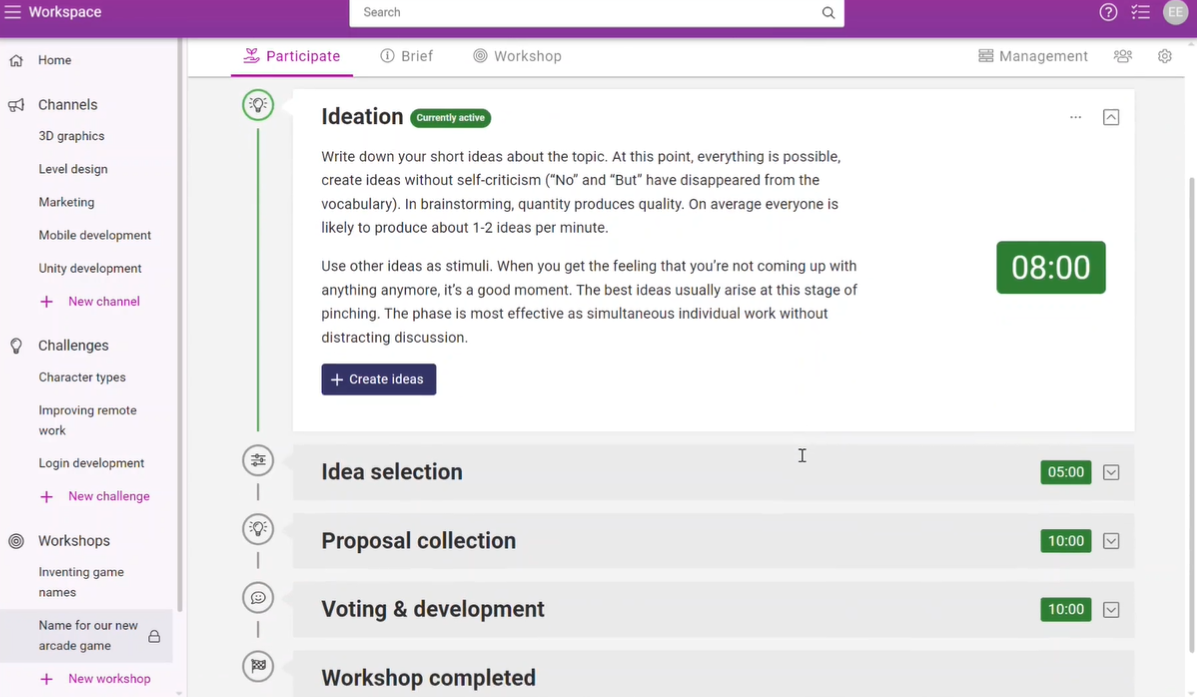
2. Start collecting ideas. Everyone should bounce some wild ideas and write them down to the app for everyone to see in real time. In a team of 3-8 people, you can collect about 100-250 ideas in 30 minutes. In Orchidea, the timer starts automatically and is visible at each step.
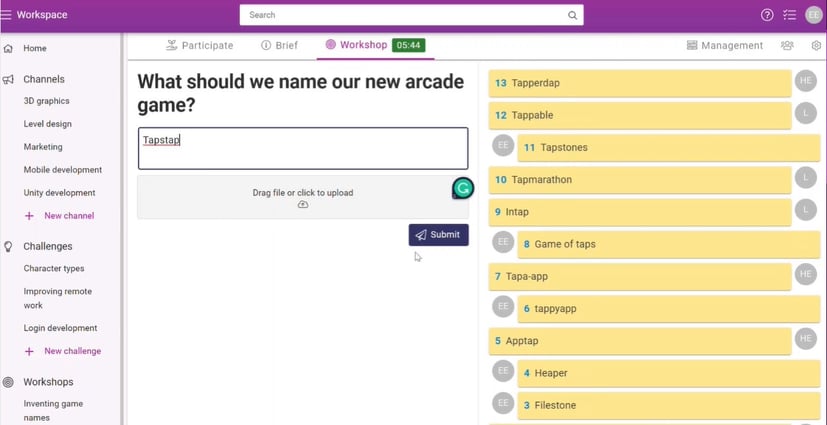
3. Select the best ideas. In the selection phase, all ideas from the previous phase are shown. Everyone reads through the ideas and drags the best ones to the next phase.
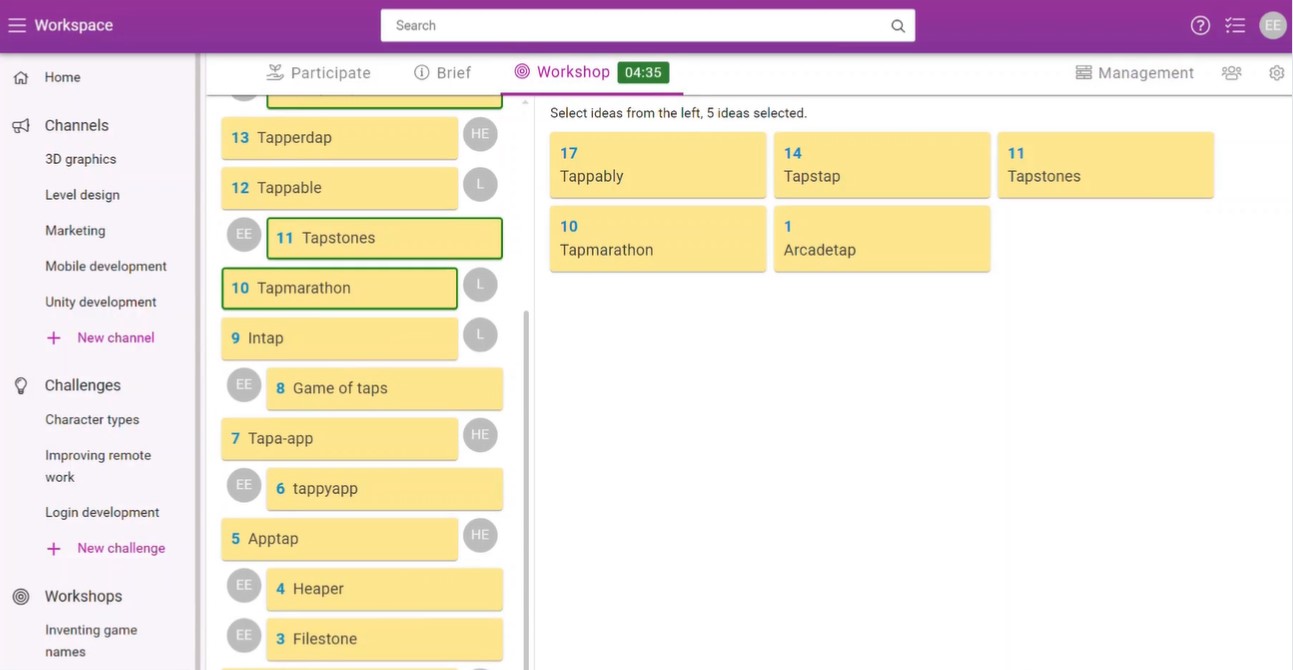
4. Collect solutions. The prioritized ideas of each participant are visible to everyone in this step. The participants form solutions out of their top 1–3 ideas. They can also add some depth to the solution by answering a few helpful questions.
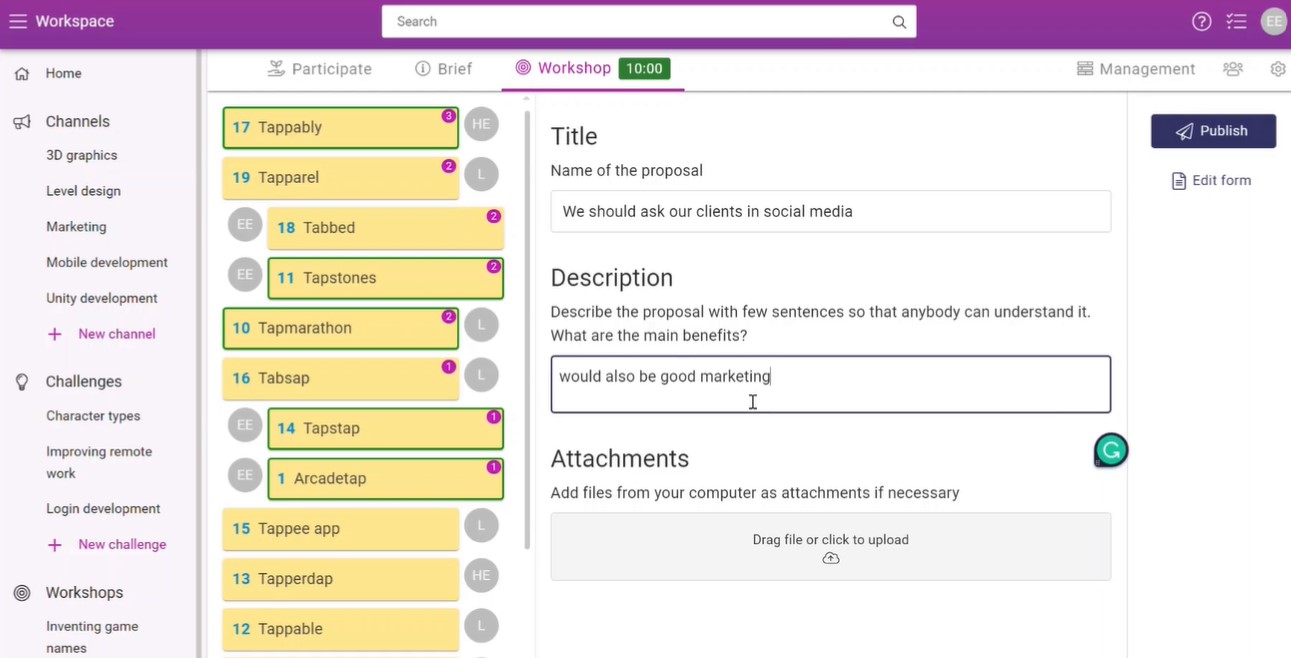
5. Develop and vote. Finally, the team develops the solutions. Solutions from the previous phase are presented in this stage. Participants read through all solutions and suggest improvements by commenting on them, asking questions, and finally voting on the best ones.
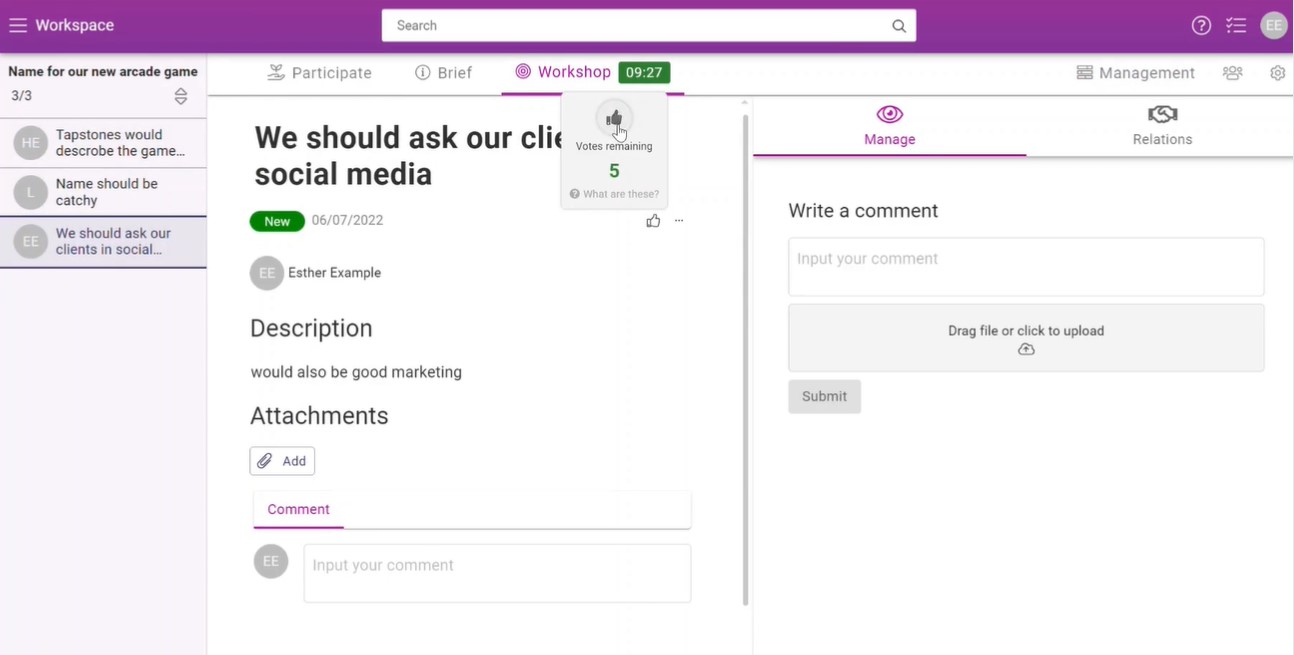
6. The facilitator sums up the session and tells what happens next with the created solutions.
The whole process is stored in Orchidea and you can export the results with one click into a Microsoft Word file.
Resources for Brainstorming
If you are interested to learn more about brainstorming, I recommend you check out these articles:
Harvard Business Review (2015) Why Group Brainstorming Is a Waste of Time
Harvard Business Review (2017) Research: for Better Brainstorming, Tell an Embarrassing Story
Harvard Business Review (2017) Your Team Is Brainstorming All Wrong
Mc Kinsey & Company (2011) Seven steps to better brainstorming
MIT Sloan School of Management (2021) Should we allow criticism while brainstorming?
Scott Berkun (2012) In Defense of Brainstorming
Closing
All in all, brainstorming is a great method for generating many outside-the-box ideas in a short time. It is a very effective tool to increase creativity and develop new innovations. You just need to pay attention to the plan and rules to make it successful.
Hopefully, this rundown helped your learning. To get better at running effective brainstorming sessions, I recommend you our other blog posts. They include some useful tips and information you should know about brainstorming.
.jpg)







.jpeg)
